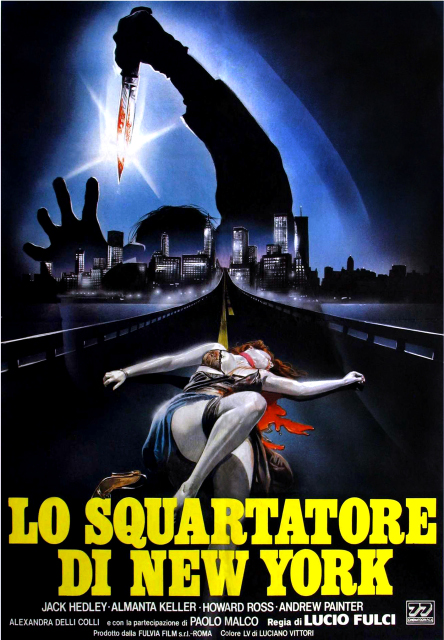RV!: The New York Ripper (1982) Dir: Lucio Fulci Date Released (VHS): March 1987 Date Seen: October 27, 2011 Rating: 4.25/5
Love this'n even more the second go-around. I wrote this introduction for when it screened at the Spectacle Theater in Williamsburg. My intros have since become more...improvised. Ad-libbed, I mean. Still, I wonder how this reads...maybe better in print than read aloud. You decide.
The movie you’re about to see was designed to fuck with you. It’s a nightmarish Hitchcockian homage with glancing sight gags that skewer the very possibility ofpsycho-analyzing a person based on their actions. It’s also a great companion piece to De Palma’s notorious and, until recently, long-unavailable Dressed to Kill, which was made in 1980, two years before Fulci directed The New York Ripper. One of the first lines in this film is an unshaved, derelict-looking guy asking his dog if he wants to play fetch: “Here, you wanna get some exercise? Ooh, my balls.” Ooh, my balls. Ahehehe yeah.
Right from this opening scene, you can tell that Fulci is going to throw as many MacGuffins and red herring clues as possible. The dog, while playing fetch, brings a hand back to his master. That hand doesn’t seem important but it is. Or at least, it will be once it’s revealed who it belongs to later in the film.
Unlike the modern-day city outside the doors of this cinema, the pre-Giuliani Time New York of Fulci’s film is a carnival-esque den of perverts and psychotics. The killer in this film famously quacks like a duck. In one of the film’s first scenes, a pretty blonde wearing a conspicuously short pair of short-shorts side-swipes a red sports car. The driver venomously screams at her, “You women should stay home, where you belong! You’re a menace to the public. You’ve got the brains of a chicken!” If the discovery of the severed hand wasn’t welcome enough, this scene serves as a proper and relatively more formal welcome to Fulci’s city.
The resident protagonists of The New York Ripper are so neurotic that it stands to reason that, since we are sutured into various different characters perspective through Point-of-view camerawork, we see the world in a uniquely unsettling light. You’re not even sure if Fulci will show you the violence in the first murder scene or not—at first: he cuts away very quickly after he’s conflated the first screams of the victim with the sound of the Staten Island ferry’s fog horn. Then he shows us the skyline. And we think the scene is over.
But then he shows the girl getting stabbed. Explicitly. Multiple times. And if you can’t tell that Fulci is screwing with you by the end of that scene, then you’ll figure it out in a few moments after this scene when a mortician callously tells Lieutenant Williams, the film’s lead male protagonist, that the killer “stuck it up her joy trail,” and that the killing was, “Good, efficient butchery.”
From there, Fulci starts to really start dish out more and more MacGuffins and red herrings and screw around with our generic expectations. Thanks to the tradition established by previous slasher films and Italian gialli, we come to expect that the women in the film that are being murdered are dying because they’re not ashamed of their sexuality. Furthemore, we think that getting the point-of-view of a character automatically implicates them. Fulci uses that to his advantage, implicating several male characters, including Lieutenant Williams, a man with eight fingers instead of ten and even Dr. Paul Davis, a psychologist and police expert. Davis’s actions are particularly loaded with meaning, like when he buys a gay porno magazine from a news stand and the vendor stuffs it between the pages of a newspaper to make him look less conspicuous. In reality, this just makes him look more schizophrenic: the respectable police expert and secret pervert. Eh, why not?
Fulci loves to visually get a rise out of attentive viewers by constantly turning the tables on anyone that’s paying strict attention to the information he’s presenting visually first and then explains afterwards via dialogue. The first time we see the killer, we see him using a switchblade. Then, during the second attack, we see the same knife again but then later, we see the killer’s face. And this time he’s holding a razor blade. After she’s attacked, lead protagonist Fay Majors, who’s played in the film by Almanta Suska, wakes up in the hospital to find the face that was chasing her has followed her to the hospital. Or at least, that’s how it looks. The face is apparently her boyfriend, making the second attack look like a very vivid bad dream—in retrospect.
There’s a lot of teasing little visual flourishes like throughout the New York Riper, so keep your eyes pealed. In her dream, the killer corners Fay and chases her into an empty movie theater. His disembodied hands pop up between the woman’s legs in what is easily the one of the film’s most memorably perverse images—of which there are many. Fay bolts upright and runs to the front of the theater in an attempt to put the killer behind her. But the killer shows up in front of her instead, as if he were a very smutty substitute for Wil E. Coyote and she were the Road Runner. And there’s so many more great and grisly little sight gags and little plot twists like that, like the syringes hidden under one of the suspected killers’ pillows or the sudden reversal of a POV shot after a suspect is handed a flyer for a porn theater with a live sex show. The New York Ripper is nothing if not excessive; you won’t leave this theater dissatisfied.

No comments:
Post a Comment